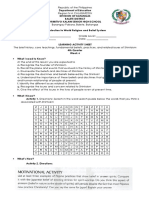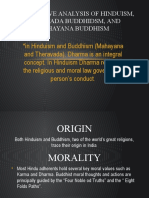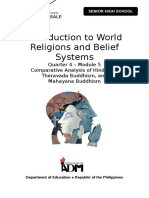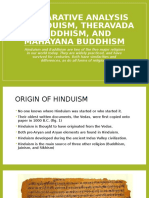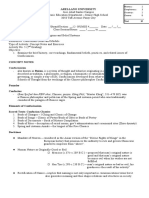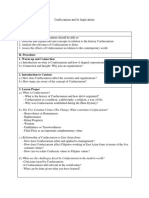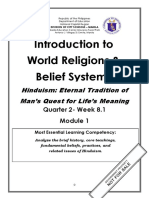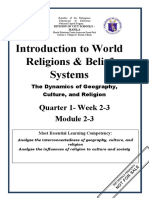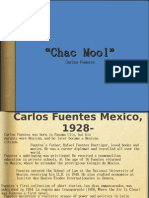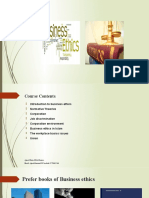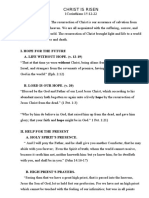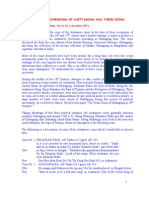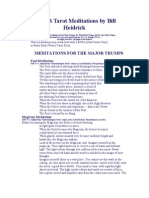ADM QTR 2 Module 6 INTRO TO WORLD RELIGION
ADM QTR 2 Module 6 INTRO TO WORLD RELIGION
Uploaded by
Krisha AraujoCopyright:
Available Formats
ADM QTR 2 Module 6 INTRO TO WORLD RELIGION
ADM QTR 2 Module 6 INTRO TO WORLD RELIGION
Uploaded by
Krisha AraujoOriginal Title
Copyright
Available Formats
Share this document
Did you find this document useful?
Is this content inappropriate?
Report this DocumentCopyright:
Available Formats
ADM QTR 2 Module 6 INTRO TO WORLD RELIGION
ADM QTR 2 Module 6 INTRO TO WORLD RELIGION
Uploaded by
Krisha AraujoCopyright:
Available Formats
INTRODUCTION TO WORLD
RELIGION AND BELIEF
SYSTEM
2ND Quarter: Module 6
Rogelio DG. Burce
Mary Ann C. Doctor
Module Writer
Department of Education • Republic of the Philippines
HUMSS – Grade 12
Alternative Delivery Mode
Quarter 2 – Module 6
First Edition, 2020
Republic Act 8293, section 176 states that: No copyright shall subsist in any work of the Government
of the Philippines. However, prior approval of the government agency or office wherein the work is created shall
be necessary for exploitation of such work for profit. Such agency or office may, among other things, impose as
a condition the payment of royalties.
Borrowed materials (i.e., songs, stories, poems, pictures, photos, brand names, trademarks, etc.) included in
this book are owned by their respective copyright holders. Every effort has been exerted to locate and seek
permission to use these materials from their respective copyright owners. The publisher and authors do not
represent nor claim ownership over them.
Published by the Department of Education
Secretary:
Undersecretary:
Assistant Secretary:
Printed in the Philippines by ________________________
Department of Education – Bureau of Learning Resources (DepEd-BLR)
Office Address: ____________________________________________
____________________________________________
Telefax: ____________________________________________
E-mail Address: ____________________________________________
12
Introduction to
World Religion and
Belief System
Quarter 2 – Module 6
SHINTOISM
Content Standard
The learner demonstrates understanding of the elements of Shintoism.
Performance Standard
The learner interprets the Kojiki creation story creatively.
Most Essential Learning (Week 14)
Intro to World Religion. Qr.2.Wk6 Rogelio DG. Burce
Examine the brief history, core teachings, fundamental beliefs, practices, and related
issues of Shintoism.
Learning Competency
● Understand the teachings and practices of Shintoism.
● Appreciate the distinctiveness of Shintoism religion.
EXPECTATION
● This module is intended to you learners of Grade 12 Humanities and Social Science
Strand classes specifically in your course subject Introduction to World Religion and
Belief System
The lesson included in your module teaches you to analyze the similarities and
differences of Theravada and Mahayana Buddhism.
● It also helps you to appreciate the differences of Theravada and Mahayana
Buddhism. In this module there are activities that will guide you to better understand
your lesson.
Are you ready and excited? Let’s start…
PRE-TEST
Multiple Choice: Read the questions carefully. Write the letter of your correct answer on the space
provided.
1. It is the comprehensive collection of Shinto mythology.
Intro to World Religion. Qr.2.Wk6 Rogelio DG. Burce
a. Amtasu Norito b. Kojiki c. Nihongi d. Naruto
2. The Japanese name for their country which means “sun origin.”
a. Nippon b. Dharpa c. Darwin d. Dhami
3. The meaning of the word ‘Shinto.’
a. “ways of men” b. “way of the people” c. “way of the gods” d.”ways of the things”
4. The name of the sun-goddess.
a. Amarus b. Amarisus c. Amorisa d. Amaterasus
5. This is the name for their many gods.
a. kanomi b. kami c. kalipa d. mika
6. It is the practice of worshipping and honoring gods and ancestral spirits.
a. tradition b. matsuri c. love for nature d. ritual purity
7. An affirmation which the main celebrations center on birth and marriage.
a. tradition b. matsuri c. love for nature d. ritual purity
8. The collection of the most important prayers and rituals of Shinto.
a. Amatasu Norito b. Kojiki c. Nihongi d. Naruto
9. Shinto’s worship many gods, called kami, that are found in mountains, rivers, rocks, trees,
a. tradition b. matsuri c. love for nature d. ritual purity
10. Followers of Shinto take baths, wash their hands, and rinse out their mouths before entering a
shrine.
a. tradition b. matsuri c. love for nature d. ritual purity
LOOKING BACK
Dare to Compare!
Provide the correct answer which shows the differences between Theravada and Mahayana.
Theme Theravada Mahayana
1. Key virtue
2. Buddha’s status
3. Ideal
INTRODUCTION OF THE LESSON
Japan: The Land of the Rising Sun
Why Japan is called “the land of the rising sun?” Basically Japan means “origin of the sun”
or “land of the rising sun.” This idea that the Japanese people
is connected to the sun goes back to the myth at the center of Shinto.
Intro to World Religion. Qr.2.Wk6 Rogelio DG. Burce
Let’s trace it back then!
Lesson: Shintoism – The National Religion of Japan
I. General Background
Shinto is purely a Japanese religion, the origins of which are buried in antiquity. The
Japanese name for their country is Nippon, which means “sun origin.” Shinto means “the way of
the kami” or “divine way.” Shinto is Japan’s indigenous religion, and its origin is as old as the
history of the Japanese culture. According to Rabbi Marc Gellman and Monsignor Thomas
Hartman, this religion didn’t have a name until Buddhism from China began appearing in Japan
(circa 500 C.E). To distinguish between the worship of the kami and the Buddha, the name of
Shinto (the way of the kami) was born. However, it was not until the late twentieth century that the
term Shinto was used to refer to a specific body of religious ideas.
II. Brief History
We cannot separate Shinto’s to Japan’s colorful history. It is the heart and soul of Japanese
very active and cooperative body system.
1. Rulership period (Prehistoric- 500 A.D)
According to Jenny King, no one knows when or how Shinto began. But Shintoists have
always worshipped the kami through nature. Shinto myths appear in the Nihongi (Chronicles of
Japan) and the Kojiki (Records of Ancient Matters) both written in the A.D. 700’s. These myths
tell how the kami created the world and established customs and laws. According to Shinto myth,
the sun goddess was the ancestor of Japan’s imperial family. Children were taught at school that
the Emperors were descendants of the sun-godess, Amaterasus who has given the imperial house
the divine right to rule.
2. Rejection period (500-800 A.D)
Beginning about the A.D. 500’s, the Chinese philosophies of Buddhism and Confucianism
began to influence Shinto. Shintoists identified Buddhist gods as kami and shrines adopted
Buddhism images to represent the kami. In the year 645, the Emperor Kotoku embraced
Buddhism and rejected Shintoism.
3. Refinement period (800-1700 A.D)
Combined with other religions, mixing with both Buddhism and Confucianism and forming
what is called Ryobu Shinto, or dual-aspect. Shinto experienced a considerable decline this period.
4. Revival period (1700-early 1800 A.D)
In 1868, the Japanese government invented State Shinto which stressed patriotism and the
divine origins of the Japanese emperor. Josh McDowell narrated that Emperor Meiji established
Shinto as the official religion of Japan in place of Buddhism. However, since the people continued to
embraced both religions, in 1877 Buddhism was allowed to be practiced by the people, with total
religious liberty granted two years afterward.
5. Realization Period (1900 A.D- Present)
After Japan’s defeat in World War II in 1945, the emperor denied that he was divine and the
government abolished the State Shinto. In the following year in a radio broadcast to the Japanese
people, Emperor Hirohito repudiated his divine right to rule and the American occupation forbade
Intro to World Religion. Qr.2.Wk6 Rogelio DG. Burce
the use of funds to support Shinto. Today many Japanese are less religious than they were before
the war. Gerald Macdermott believe that most Japanese are indifferent to the emperor politically,
but they respect him at the very least as the foremost representative of the world’s oldest ruling
dynasty.
III. Sacred Writings
Three major writings reflects the content of Shinto, though we should think of them as
descriptive rather than as Shinto rule books
1. Kojiki (Records of Ancient Matters) – a comprehensive collection of Shinto mythology which
tells the story of how gods (kami) came into being.
Kojiki Creation story:
The Japanese story of national origins is the myth of the Sun Goddess. Our earliest record of
this goes back to A.D 720. The world is said to have started in primordial chaos, out of which arose
a succession of seven generations of gods. The seventh are brother and sister gods named Izanagi
(the brother) and Izanami (the sister), who became husband and wife. Her urine, feces, and vomit
become matter, earth, and the ocean. They create the gods (kami) of nature. Then three chief gods:
Amaterasu Omikami, the Sun Goddess; the Moon God; and Susanowo, the god of storms and seas.
Izagani and Izanami married and created the Japanese islands. Izanami died and went into the
underworld. Amaterasu (sun-goddess) would not show her face for a time and became the ancestor
of the emperor of Japan.
2. Nihongi (Chronicles of Japan) – compilation of all the variations in the same story as the Kojiki.
3. The Amatasu Norito – the collection of the most important prayers and rituals of Shinto.
IV. Core Beliefs
Four Affirmations
1. Tradition and family
The family is the foundation for preserving traditions. Their main celebrations center on birth
and marriage.
2. Love of nature
Nature is sacred, and natural objects are worshipped as sacred spirits.
Historian prefers to describe Shinto as the native religion of Japan and dates it from prehistoric
times. Shinto’s worship many gods, called kami, that are found in mountains, rivers, rocks, trees,
and other parts of nature. It is concerned with being in harmony with nature.
3. Ritual purity
Followers of Shinto take baths, wash their hands, and rinse out their mouths before entering
a shrine where they will worship the kami. Many of the sacred shrines are built near flowing water
to help the people maintain their state of purity. Twice a year, festivals are held to drive out
pollutants or impurities.
4. Matsuri
This is the practice of worshipping and honoring gods and ancestral spirits. Great
Purification Ceremony is the most important matsuri which consists of a confession of sins
committed by individuals and by the nation and followed by request that kami remove the impure
Intro to World Religion. Qr.2.Wk6 Rogelio DG. Burce
conditions caused by these sins. Other ceremonies deal with such basic goals as long life, peace,
abundant harvests and good health.
V. Major Practices
According to Joseph Gaer, today many Shinto’s sects are almost, although not as quite, as
diverse as the Christian sects. But all of them adhere to the basic tenets that teach them.
“To be courageous, loyal, and to observe cleanliness; That the Father and Mother of the
Japanese race stem from Izanagi and Izanami; That life is good; That the world reveals itself in
beauty – particularly in dignity and simplicity; and that deeds are more important than arguments.”
Among the sects that have evolved formal Decalogues are two, The Shinri Kyo, and
Shinshu Kyo.
Ten Precepts of Shinri Kyo Ten Precepts of Shinshu Kyo
1. Do not transgress the will of the gods. 1. Worship the great deities of this sect.
2. Do not forget your obligations to 2. Pacify the spirit, for it is part of the spirit
ancestors. of deity.
3. Do not transgress the decrees of the 3. Practice the Way of the Gods.
State.
4. Do not forget the profound goodness of 4. Revere the divine origin of the State.
the gods whereby misfortune is averted and
sickness is healed.
5. Do not forget that the world is one 5. Be loyal to the ruler.
family.
6. Do not forget the limitations of your own 6. Be zealous in filial piety toward thy
person. parents.
7. Even though others become angry, do 7. Be kind to others.
not become angry yourself.
8. Do not be slothful in your business. 8. Be diligent in business.
9. Do not be a person who brings blame to 9. Preserve steadfastness within thy breast.
the teaching.
10. Do not be carried away by foreign 10. Cleanse away the rust of thy body.
teaching.
What’s More?
Activity 1: The Confluence of Religion to Japanese Culture
Explain the connections of Shinto religion to Japanese culture and government.
Areas of Connections of Religion
Concern
Intro to World Religion. Qr.2.Wk6 Rogelio DG. Burce
1. Government
2. Arts
3. Health
4. Morality
5. Beliefs
Guide Questions;
1. Which do you think has the strongest influence of Shintoism in Japanese institution? Explain.
_________________________________________________________________________________________
2. Do you think because of Shintoism why Japanese has a strong self-discipline and respect for
nature? Why?
__________________________________________________________________________________________________
____________________________________________________________________________________
Moving On!
Activity 2- Interpret the Japanese Secret!
Give your own interpretation of the “Kojiki Creation’s Story.” What is the significance of
this story in Japanese history, religion and culture?
Country of Japan Significance of Kojiki Creation’s Story
1. History (politics)
2. Religion (beliefs)
3. Culture (way of
life)
Rubrics:
Content (5 points) – the explanation given is precise and convincing.
Presentation (5 points) – The contractions of sentence and ideas are correct and clear.
Intro to World Religion. Qr.2.Wk6 Rogelio DG. Burce
What I have learned: Activity 3: Filipino Flavor
Look into the flavor of Filipino culture which very evident in Shintoism religion.
Japanese Culture Filipino Culture
Ex. Respect for the elders thru Respect for the elders through
veneration and rituals pagmamano
1.
2.
3.
CHECKING YOUR UNDERSTANDING
What I CAN Do?
A. Write R if the statement Represents the teachings and practices of Shintoism and D, if Denies it.
_____ 1. Most Shinto’s are nature-lover.
_____ 2. Orphanages for the elder are common among the Shinto’s.
_____ 3. Japanese has more tendencies to rebel against authorities.
_____ 4. They do not display any images in their homes.
_____ 5. Shrines are very popular in every place.
_____ 6. Rituals are strictly prohibited.
_____ 7. Cleanliness is one of their primary values.
_____ 8. They honor only one god and creator of everything.
_____ 9. Patriotism and loyalty to govern are emphasized.
____10. Japanese are very accommodating with other religions.
B. Identify the historical period of the following description.
11. Combined with other religions, mixing with both Buddhism and Confucianism and forming
what is called Ryobu Shinto, or dual-aspect.
12. During this time the Japanese government invented State Shinto which stressed patriotism and
the divine origins of the Japanese emperor.
13. In the year 645, the Emperor Kotoku embraced Buddhism and rejected Shintoism.
Intro to World Religion. Qr.2.Wk6 Rogelio DG. Burce
14. Most Japanese are indifferent to the emperor politically, but they respect him.
15. A time when the Emperors were taught descendants of the sun-godess, Amaterasus who has
given the imperial house the divine right to rule.
ENRICHMENT
Congratulations! You’re almost done in attaining a well-oriented status in Shintoism
religion. Kindly, answer the following questions.
1. What is the most significant influence of Shintoism religion in our society?
________________________________________________________________________________________
2. Would it be possible for Japan to have its own identity without the Shintoism?
_________________________________________________________________________________________
Inihanda ni;
Mr. Rogelio D.G Burce
Bagong Barrio Senior High School
Teacher 1
Intro to World Religion. Qr.2.Wk6 Rogelio DG. Burce
Referrences:
Mga Sanggunian:
Corduan, Winfried. “Guide to World Religions,” Intervarsity Press.USA.2006
Mcdermott, Gerald R. “World Religion- An indispensible Introduction, Thomas Nelson.USA.2011
Gaer, Joseph, “What the Great religions Believe,” New American Library.USA.1963
King, Jenny, “World’s Religions,” Worldlinks Books.Philippines.2002
Gellman, Marc, Hartman, Thomas Religion for Dummies,“Wiley Publishing. USA. 2002
McDowell, Josh, “The Best of Josh McDowell- A Ready Defense,”Thomas Nelson.USA.1993
Answers Key
PRE-T REVIEW EVALUATION
EST
1. B 1. R 11. REFINEMENT
2. B 2. D 12. REVIVAL
3. C 3. D 13. REJECTION
4. D 4. D 14. REALIZATION
5. B 5. R 15. RULERSHIP
6. B 6. D
7. A 7. R
8. A 8. D
9. C 9. R
10. D 10. R
.
Intro to World Religion. Qr.2.Wk6 Rogelio DG. Burce
You might also like
- Vdocuments - MX - The Blood Grace Ryerson Roos PDFDocument27 pagesVdocuments - MX - The Blood Grace Ryerson Roos PDFfisayobabs11100% (7)
- Intro To World Religion DLL Week 1Document7 pagesIntro To World Religion DLL Week 1Roy Cedric Recede100% (4)
- Shs Work Immersion E-PortfolioDocument44 pagesShs Work Immersion E-PortfolioKrisha AraujoNo ratings yet
- Introduction To World Religions & Belief Systems: 2 Quarter: Module 5Document14 pagesIntroduction To World Religions & Belief Systems: 2 Quarter: Module 5Krisha Araujo100% (1)
- HOPE 3 Module 1Document19 pagesHOPE 3 Module 1Krisha Araujo100% (2)
- Disciplines and Ideas in The Applied Social Sciences: 1st Quarter: Module 7 The Discipline of CommunicationDocument8 pagesDisciplines and Ideas in The Applied Social Sciences: 1st Quarter: Module 7 The Discipline of CommunicationKrisha Araujo93% (14)
- Final Output in Practical Research 2Document48 pagesFinal Output in Practical Research 2Krisha Araujo83% (6)
- Writers: Dan Davy P. Azarcon: Ritchie Descartin Amy Faith SusonDocument13 pagesWriters: Dan Davy P. Azarcon: Ritchie Descartin Amy Faith Susonamy faith suson100% (2)
- WORKSHEET-WEEK 9: DHARMIC RELIGION: Theravada Buddhism: Introduction To World Religions and Belief SystemsDocument12 pagesWORKSHEET-WEEK 9: DHARMIC RELIGION: Theravada Buddhism: Introduction To World Religions and Belief SystemsAshierah MontasNo ratings yet
- Week 2 DLP Origin of ReligionDocument11 pagesWeek 2 DLP Origin of ReligionAbastar Kycie Beb100% (3)
- The Cultural Milieu: On Monotheism and UniversalityDocument3 pagesThe Cultural Milieu: On Monotheism and Universalityjulie rose100% (1)
- Iwrbs 2nd Quarter Module 7Document12 pagesIwrbs 2nd Quarter Module 7jetirish saballaNo ratings yet
- Introduction To World Religions & Belief Systems: Quarter 2Document13 pagesIntroduction To World Religions & Belief Systems: Quarter 2Letty RamosNo ratings yet
- IWRBS.Q4 Week 6 ShintoismDocument22 pagesIWRBS.Q4 Week 6 ShintoismelizaldeNo ratings yet
- World Religion Lesson 4Document3 pagesWorld Religion Lesson 4Pearl Arianne Montealegre100% (2)
- Daoic ReligionDocument12 pagesDaoic ReligionLiezl Aplando Villanueva100% (1)
- Comparative Analysis of Hinduism, Theravada BuddhidsmDocument4 pagesComparative Analysis of Hinduism, Theravada BuddhidsmAlmirah100% (3)
- M3-Introduction To World ReligionsDocument12 pagesM3-Introduction To World ReligionsDave Mark OlaguirNo ratings yet
- Humss11 - Intro - q2 - Mod10 - Mahayana BuddhismDocument31 pagesHumss11 - Intro - q2 - Mod10 - Mahayana BuddhismYuma YumaNo ratings yet
- Introduction To World Religions and Belief Systems: Pre-TestDocument12 pagesIntroduction To World Religions and Belief Systems: Pre-TestJanina Q. Chan0% (1)
- World Religion 11 - Module - Lesson 8&9Document6 pagesWorld Religion 11 - Module - Lesson 8&9John ClarenceNo ratings yet
- Positive and Negative Effects of ReligionDocument31 pagesPositive and Negative Effects of ReligionRicky Canico ArotNo ratings yet
- Q1 SHS Intro To World Religion Module 4Document21 pagesQ1 SHS Intro To World Religion Module 4maricar relator100% (1)
- World Religions - Q2 - Module 12Document11 pagesWorld Religions - Q2 - Module 12Ira Jane CaballeroNo ratings yet
- Final Module Intro To World ReligionsDocument17 pagesFinal Module Intro To World ReligionsKevin Rey Caballeda100% (1)
- HUMSS IWRBS Module 1 Concept Elements and Characteristics of Belief System World View Religion and SpiritualityDocument13 pagesHUMSS IWRBS Module 1 Concept Elements and Characteristics of Belief System World View Religion and SpiritualityJeffrey De Belen100% (1)
- ADM QTR 3 Module 1 INTRO TO WORLD RELIGIONDocument11 pagesADM QTR 3 Module 1 INTRO TO WORLD RELIGIONLemuel Cabrera Nepomuceno100% (1)
- WORKSHEET-WEEK 7: Comparative Analysis of Judaism, Christianity, and IslamDocument27 pagesWORKSHEET-WEEK 7: Comparative Analysis of Judaism, Christianity, and IslamAshierah Montas100% (2)
- Week 11 World RelgionDocument10 pagesWeek 11 World RelgionRitz Anton LimNo ratings yet
- Session 1: Humss - Wrb12-Ii/Ive-12.1 Humss - Wrb12-Ii/Ive-12.2Document4 pagesSession 1: Humss - Wrb12-Ii/Ive-12.1 Humss - Wrb12-Ii/Ive-12.2Dee Jay AsuncionNo ratings yet
- Introduction To World Religions and Belief SystemsDocument12 pagesIntroduction To World Religions and Belief SystemsFRECY MARZANNo ratings yet
- World Religions Module 6Document8 pagesWorld Religions Module 6Juvic M. LeycoNo ratings yet
- SHS Introduction To World Religions and Beliefs ActivitiesDocument37 pagesSHS Introduction To World Religions and Beliefs ActivitiesAnonymous Rl5sWyCIFK100% (7)
- Introduction To World Religions and Belief SystemsDocument23 pagesIntroduction To World Religions and Belief SystemsADONIS ARANILLONo ratings yet
- IWRBS w2 RaquellaroyaDocument23 pagesIWRBS w2 RaquellaroyaGlennCorpuzNo ratings yet
- Introduction To World Religions and Belief Systems: Lesson TitleDocument17 pagesIntroduction To World Religions and Belief Systems: Lesson TitleFRECY MARZAN100% (2)
- IWTR Module 3 Final EditingDocument22 pagesIWTR Module 3 Final Editingcheshire chnNo ratings yet
- Evidence About ReligionDocument12 pagesEvidence About ReligionKaren Mae Sibal100% (2)
- Dharmic Religions Comparative AnalysisDocument4 pagesDharmic Religions Comparative AnalysisPatrick Rabi100% (1)
- World Religions Module 5Document7 pagesWorld Religions Module 5Juvic M. LeycoNo ratings yet
- Iwrbs 2nd Quarter Module 4Document10 pagesIwrbs 2nd Quarter Module 4jetirish saballaNo ratings yet
- PPG La Union Module 12Document18 pagesPPG La Union Module 12Fobe Lpt NudaloNo ratings yet
- Introduction To World Religions and Belief SystemsDocument16 pagesIntroduction To World Religions and Belief SystemsSophia Egos100% (2)
- Comparative AnalysisDocument13 pagesComparative AnalysisJk Ian100% (1)
- TOS in SHS - Doc@religionDocument16 pagesTOS in SHS - Doc@religionRaquel Domingo100% (1)
- DLP 5 ConfucianismDocument3 pagesDLP 5 ConfucianismAshley Jade Hanna Flores100% (3)
- WRBS Las Q2-Week 6Document3 pagesWRBS Las Q2-Week 6Jaharah FilipinoNo ratings yet
- 4th QUARTER EXAMINATION IN IWRBSDocument3 pages4th QUARTER EXAMINATION IN IWRBSMark Louise PacisNo ratings yet
- World Religions Quarter 4 Module 8 PDFDocument20 pagesWorld Religions Quarter 4 Module 8 PDFKELLY LLANERANo ratings yet
- How Does Awareness On The Positive and Negative Effects of Religion Promote Tolerance and Understanding Among Believers.?Document10 pagesHow Does Awareness On The Positive and Negative Effects of Religion Promote Tolerance and Understanding Among Believers.?amy faith suson100% (2)
- LESSON PLAN World Religion Week 2Document3 pagesLESSON PLAN World Religion Week 2VIRGILIO JR FABINo ratings yet
- Iwrbs Long QuizDocument3 pagesIwrbs Long Quizgamms upNo ratings yet
- Lesson PlanDocument2 pagesLesson PlanNoginBunda100% (2)
- IWRBS - Q1 - Mod1 - Worldviews Belief Systems and ReligionDocument9 pagesIWRBS - Q1 - Mod1 - Worldviews Belief Systems and Religionian esplanaNo ratings yet
- Grade 11 - HUMSS - Araling Panlipunan - World Religions - Week 3Document7 pagesGrade 11 - HUMSS - Araling Panlipunan - World Religions - Week 3giansulakisosuNo ratings yet
- Introduction To World Religions MODULE 1 4Document43 pagesIntroduction To World Religions MODULE 1 4kyjmNo ratings yet
- Introduction To World Religions & Belief Systems: Hinduism: Eternal Tradition of Man's Quest For Life's MeaningDocument17 pagesIntroduction To World Religions & Belief Systems: Hinduism: Eternal Tradition of Man's Quest For Life's MeaningLetty Ramos100% (3)
- Introduction To World Religions & Belief Systems: Quarter 1-Week 2-3 Module 2-3Document19 pagesIntroduction To World Religions & Belief Systems: Quarter 1-Week 2-3 Module 2-3remah guingabNo ratings yet
- To World Religions & Belief Systems: 1 Quarter: Module 5Document16 pagesTo World Religions & Belief Systems: 1 Quarter: Module 5Janess Hernandez100% (1)
- Positive & Negative Effects of ReligionDocument70 pagesPositive & Negative Effects of Religionlucille100% (1)
- Simplified Budget of Lessons in Introduction To World Religions and Belief SystemsDocument2 pagesSimplified Budget of Lessons in Introduction To World Religions and Belief SystemsLOWIE ATCHASO100% (2)
- Shintoism EditedDocument22 pagesShintoism Editedrmnosh0822No ratings yet
- IWRBS M14 MacdonaldvenidaDocument18 pagesIWRBS M14 MacdonaldvenidaGlennCorpuzNo ratings yet
- Theology of ShintoDocument20 pagesTheology of ShintoKira YozukiNo ratings yet
- Third Trimester School Year 2020-2021 Shintoism: MODULE 9 - World ReligionDocument5 pagesThird Trimester School Year 2020-2021 Shintoism: MODULE 9 - World ReligionJulian Gabriel TrinidadNo ratings yet
- Aplication For Employment: Personal InformationDocument1 pageAplication For Employment: Personal InformationKrisha AraujoNo ratings yet
- HOPE 3 Module 2Document17 pagesHOPE 3 Module 2Krisha Araujo100% (2)
- Introduction To World Religions & Belief Systems: 2 Quarter: Module 4Document14 pagesIntroduction To World Religions & Belief Systems: 2 Quarter: Module 4Krisha AraujoNo ratings yet
- SHS-12 Entrepreneurship Quarter-2 Week2Document9 pagesSHS-12 Entrepreneurship Quarter-2 Week2Krisha Araujo100% (1)
- SHS - 12 - Entrepreneurship Quarter 2 Week 4 and 5Document17 pagesSHS - 12 - Entrepreneurship Quarter 2 Week 4 and 5Krisha AraujoNo ratings yet
- Creative Writing Q2 Week 1 1 1Document11 pagesCreative Writing Q2 Week 1 1 1Krisha Araujo100% (2)
- SHS-12 Entrepreneurship Quarter-2 Week-3Document9 pagesSHS-12 Entrepreneurship Quarter-2 Week-3Krisha AraujoNo ratings yet
- Creative Writing: Conceptualize A Character/setting/plot For A One-Act PlayDocument11 pagesCreative Writing: Conceptualize A Character/setting/plot For A One-Act PlayKrisha Araujo100% (1)
- Sai VijayamDocument9 pagesSai VijayamJose Luis CallieriNo ratings yet
- Chac Mool IntroDocument8 pagesChac Mool Introlzee100% (2)
- Ruhi Workshop Planning Youth ConferenceDocument6 pagesRuhi Workshop Planning Youth ConferenceAdy CookNo ratings yet
- SC Church DirectoryDocument5 pagesSC Church Directorycrashingtothesea100% (2)
- Christine Margerrison - Ces Forces Obscures de L'âme Women, Race and Origins in The Writings of Albert CamusDocument357 pagesChristine Margerrison - Ces Forces Obscures de L'âme Women, Race and Origins in The Writings of Albert CamusAivlysNo ratings yet
- World Religions W4Document5 pagesWorld Religions W4Chrislyn TingsonNo ratings yet
- LFL BookletDocument4 pagesLFL BookletbenedictNo ratings yet
- Meg 18 AssignmentDocument3 pagesMeg 18 AssignmentThe truth tellerNo ratings yet
- Danner Lecture 2003Document22 pagesDanner Lecture 2003Anggara LesmanaNo ratings yet
- Academic Calendar Of: Ec 1-3 Classes - Ec 4-6 Classes Lbpp-Lia MakassarDocument6 pagesAcademic Calendar Of: Ec 1-3 Classes - Ec 4-6 Classes Lbpp-Lia MakassarLukman ArifuddinNo ratings yet
- REBATIDocument20 pagesREBATIantonapoulos100% (5)
- Proceedings-Vol 09 No 08-Oct-Nov-Dec-1971 (George Van Tassel)Document16 pagesProceedings-Vol 09 No 08-Oct-Nov-Dec-1971 (George Van Tassel)Homers Simpson100% (3)
- K.U. Philosophy Hons CBCS 2018Document33 pagesK.U. Philosophy Hons CBCS 2018monalisaNo ratings yet
- 01 Business EthicsDocument21 pages01 Business EthicsGullabudin Hassan ZadaNo ratings yet
- Reflection On My VocationDocument10 pagesReflection On My VocationRobert BadrinaNo ratings yet
- Qasida Ghausia - Abd Al-Qadir Al-JilaniDocument14 pagesQasida Ghausia - Abd Al-Qadir Al-JilaniMystic AamirNo ratings yet
- Murtaza Vali: Kazi in Nomansland and The Crisis of HistoryDocument4 pagesMurtaza Vali: Kazi in Nomansland and The Crisis of HistorymohaiemenNo ratings yet
- Page 8bcultureissueDocument1 pagePage 8bcultureissueapi-307936954No ratings yet
- IndigenousDocument12 pagesIndigenousrachNo ratings yet
- Christ Is Risen: INTRODUCTION: The Resurrection of Christ Is Our Assurance of Salvation FromDocument2 pagesChrist Is Risen: INTRODUCTION: The Resurrection of Christ Is Our Assurance of Salvation FromChris IyaNo ratings yet
- Nine Planets MantraDocument14 pagesNine Planets Mantravshadeesh0% (1)
- Research Paper FullDocument24 pagesResearch Paper Fullapi-349033369No ratings yet
- St. Mary'S College of Tagum, Inc.: Undergraduate ActivityDocument2 pagesSt. Mary'S College of Tagum, Inc.: Undergraduate Activityangelica barruelaNo ratings yet
- Tatays EulogyDocument4 pagesTatays EulogyMorris RamosNo ratings yet
- Balabodha Sangraham - 3Document117 pagesBalabodha Sangraham - 3Nagendra Krishnamurthy100% (1)
- The Arakanese Governors of Chittagong and Their CoinsDocument8 pagesThe Arakanese Governors of Chittagong and Their CoinsmayunadiNo ratings yet
- Bill Heidrick - Tarot MeditationsDocument30 pagesBill Heidrick - Tarot MeditationsNancy ZecchelNo ratings yet
- Physiology of Behavior 12th Edition Carlson Test BankDocument25 pagesPhysiology of Behavior 12th Edition Carlson Test BankKarenChapmankzabj100% (43)
- Screenshot 2021-08-25 at 9.37.51 PMDocument1 pageScreenshot 2021-08-25 at 9.37.51 PMAbhisheck BadjatiaNo ratings yet













